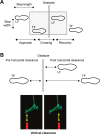Different protocols for analyzing behavior and adaptability in obstacle crossing in Parkinson's disease
- PMID: 29158667
- PMCID: PMC5683812
- DOI: 10.2147/CIA.S147428
Different protocols for analyzing behavior and adaptability in obstacle crossing in Parkinson's disease
Abstract
Imbalance and tripping over obstacles as a result of altered gait in older adults, especially in patients with Parkinson's disease (PD), are one of the most common causes of falls. During obstacle crossing, patients with PD modify their behavior in order to decrease the mechanical demands and enhance dynamic stability. Various descriptions of dynamic traits of gait that have been collected over longer periods, probably better synthesize the underlying structure and pattern of fluctuations in gait and can be more sensitive markers of aging or early neurological dysfunction and increased risk of falls. This confirmation challenges the clinimetric of different protocols and paradigms used for gait analysis up till now, in particular when analyzing obstacle crossing. The authors here present a critical review of current knowledge concerning the interplay between the cognition and gait in aging and PD, emphasizing the differences in gait behavior and adaptability while walking over different and challenging obstacle paradigms, and the implications of obstacle negotiation as a predictor of falls. Some evidence concerning the effectiveness of future rehabilitation protocols on reviving obstacle crossing behavior by trial and error relearning, taking advantage of dual-task paradigms, physical exercise, and virtual reality have been put forward in this article.
Keywords: Parkinson’s disease; aging; behavior; cognition; falls; gait; obstacle crossing.
Conflict of interest statement
Disclosure The authors report no conflicts of interest in this work.
Figures






References
-
- Peterka RJ, Loughlin PJ. Dynamic regulation of sensorimotor integration in human postural control. J Neurophysiol. 2004;91(1):410–423. - PubMed
-
- Balash Y, Peretz C, Leibovich G, Herman T, Hausdorff JM, Giladi N. Falls in outpatients with Parkinson’s disease: frequency, impact and identifying factors. J Neurol. 2005;252(11):1310–1315. - PubMed
Publication types
MeSH terms
LinkOut - more resources
Full Text Sources
Other Literature Sources
Medical

